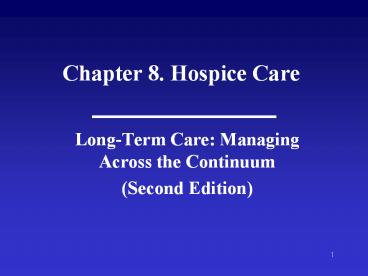Chapter 8. Hospice Care - PowerPoint PPT Presentation
Title:
Chapter 8. Hospice Care
Description:
Chapter 8. Hospice Care Long-Term Care: Managing Across the Continuum (Second Edition) Learning Objectives Define hospice care and those who use it Identify sources ... – PowerPoint PPT presentation
Number of Views:643
Avg rating:3.0/5.0
Title: Chapter 8. Hospice Care
1
Chapter 8. Hospice Care
- Long-Term Care Managing Across the Continuum
- (Second Edition)
2
Learning Objectives
- Define hospice care and those who use it
- Identify sources of financing of hospice care
- Identify and describe regulations affecting
hospice care providers - Understand and discuss ethical issues affecting
hospice care - Identify trends affecting hospice care and the
impact of those trends
3
What is Hospice Care?
- Program for people with terminal illnesses
- End-of-life care
4
How Hospice Care Developed
- Began as a formal program in England in 1967
- First American hospice in Connecticut in 1974
- Has grown rapidly in recent years
5
Philosophy of Care
- Not a place, but a philosophy
- Provides support for terminally ill and their
families - Neither prolongs life nor hastens death
- Focus on comfort (palliative) care
- Promotes dignity in final days
6
Benefits of Hospice Care
- Cost-effective alternative
- Lets patients stay in their homes with their
families - Interdisciplinary team
- Treats person, not disease
- Emphasizes quality of life
7
Ownership
- Many are affiliated with other health care
organizations - Home health care agencies
- Hospitals
- SNFs
- Most are nonprofit
- Some are freestanding
8
Services Provided
- Medical Nursing
- Social Services Counseling
- Medical Supplies Therapy
- Pain Management Homemaking
- Personal care Education
9
Consumers of Hospice Care
- Terminally ill
- Cancer Diabetes
- Heart disease Kidney disease
- Pulmonary disease Liver disease
- Neurological AIDS
- disease
- Their families
10
Market Forces
- Cost-effectiveness
- Desire for control during last days of life
11
Regulations
- Medicare certification
- State licensure
12
Accreditation
- JCAHO
- CHAP
- ACHC
13
Financing
- Medicare
- Benefit periods
- Six months or less to live
- Pays for most services
- Medicaid
- Private insurance
- Self-pay and other sources
14
Staffing
- Medical Director Personal Physician
- Nurses Social Workers
- Hospice Aides Clergy
- Bereavement Therapists Counselors
Nutritionists - Volunteers Caregiver
- Patient
15
Legal Ethical Issues
- Decision to accept hospice care
- Rights of patients
- Advance directives
- Physician-assisted suicide
- Survival past 6 months
- Inequitable access
16
Management Qualifications
- Not regularly licensed
- Medicare Conditions of Participation
17
Management Challenges Opportunities
- Coordinating professional and volunteer staff
- The emotional element
- Cultural, religious, and ethnic differences
- Community and philanthropic groups
18
Significant Trends
- Variation in access and use
- Later admission, shorter stays
- Alternative therapies
- Expansion of eligibility
19
In Summary
- Hospice care has a long history, but has become
increasingly attractive in recent years, and
should continue to grow.





![[PDF] Palliative Care Nursing: Quality Care to the End of Life, Fifth Edition - New Chapter Included - Instructor Resources Kindle PowerPoint PPT Presentation](https://s3.amazonaws.com/images.powershow.com/10084282.th0.jpg?_=20240724124)





![[PDF] Risk Management Handbook for Health Care Organizations Free PowerPoint PPT Presentation](https://s3.amazonaws.com/images.powershow.com/10096742.th0.jpg?_=202408121211)












![[PDF] Evidence-Based Practice of Palliative Medicine Android PowerPoint PPT Presentation](https://s3.amazonaws.com/images.powershow.com/10080814.th0.jpg?_=202407180310)






